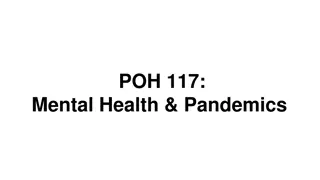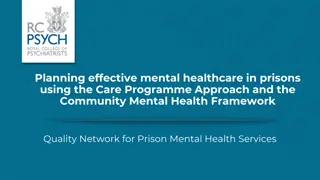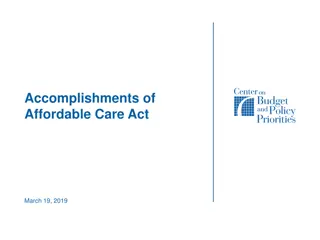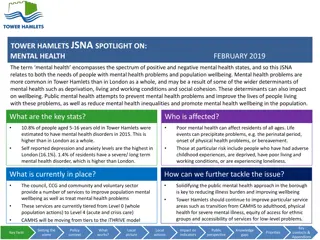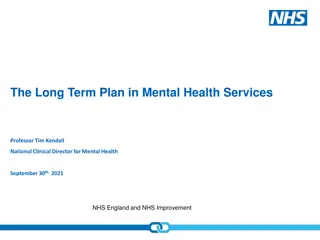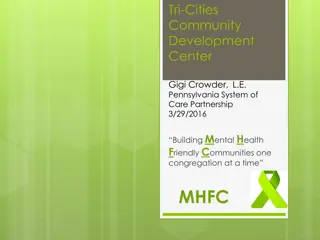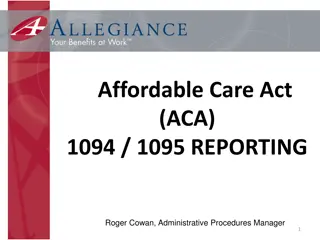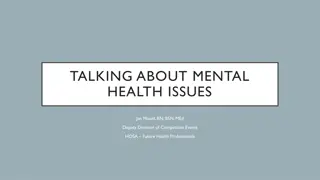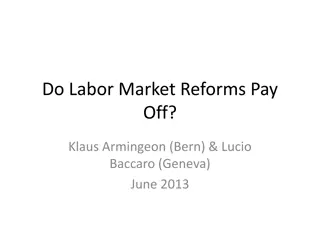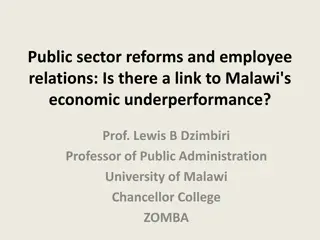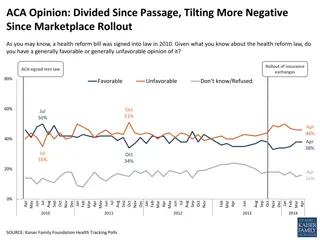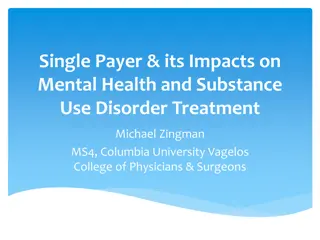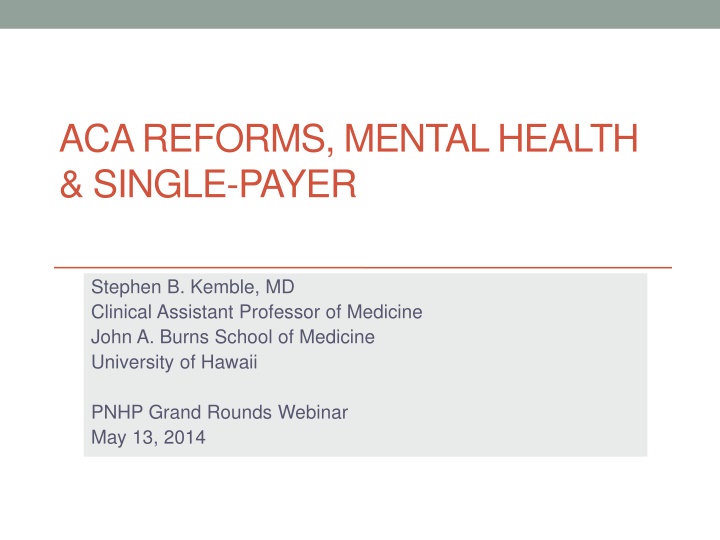
Problems with U.S. Healthcare System: Cost, Access, and Reform Efforts
Explore the challenges of the U.S. healthcare system, including high costs, limited access, and the implications of healthcare reform initiatives. Gain insights into the impact on patients, providers, and the overall system at large.
Uploaded on | 0 Views
Download Presentation

Please find below an Image/Link to download the presentation.
The content on the website is provided AS IS for your information and personal use only. It may not be sold, licensed, or shared on other websites without obtaining consent from the author. If you encounter any issues during the download, it is possible that the publisher has removed the file from their server.
You are allowed to download the files provided on this website for personal or commercial use, subject to the condition that they are used lawfully. All files are the property of their respective owners.
The content on the website is provided AS IS for your information and personal use only. It may not be sold, licensed, or shared on other websites without obtaining consent from the author.
E N D
Presentation Transcript
ACA REFORMS, MENTAL HEALTH & SINGLE-PAYER Stephen B. Kemble, MD Clinical Assistant Professor of Medicine John A. Burns School of Medicine University of Hawaii PNHP Grand Rounds Webinar May 13, 2014
Disclosure No financial conflicts of interest to disclose. I receive no money whatsoever for any of my involvement in health care reform and health policy activities.
The Big Problems with U.S. Healthcare Cost Access We must reduce cost, and restricted access to care is the price we must pay to control cost. Right?
BUT - 1. Restricting care and access does not restrict disease Pops up in uncontrolled and more expensive forms elsewhere (complications, ER, hospital) Pushed onto US default high risk pools Medicaid and Medicare 2. Bureaucracy Restricting care, access, or eligibility all require bureaucracies that cost more than they save.
The Affordable Care Act: Attributes excess cost to too much care Blames fee-for-service causing excessive volume of services Financial incentives for doctors and hospitals to deliver less care Increased cost-shifting to patients
US Public Spending for Health Exceeds Total Spending in Other Nations $10,000 2011 healthcare spending per capita $8,950 $8,000 $3,201 $6,000 $5,640 $5,749 $4,970 $4,780 $4,000 $4,350 $3,970 $3,280 $3,140 $2,940 $2,000 $- JAP UK SWE FRA GER CAN HOL SWI USA Total US Public US Private Data are for 2011 Sources: OECD 2013; Health Affairs 2002 21(4)88
Cost and Access Problems Among Sicker Adults U.S. Access Is Worse 50% 40% Percent Reporting Problems (Among Sicker Adults) 30% 20% 10% 0 UK France Canada Austral. N. Zeal. USA Hard to Pay Med Bills Cost Was Access Problem Source: Health Affairs 2011;30:2437
Life Expectancy 83 82.7 82 82.2 81.9 Years 81 81.1 81.0 80.8 80 79 78.7 78 77 76 USA Germany Canada UK Sweden France Italy Note: Data are for 2011 or most recent year available Source: OECD, 2013
Decline in Preventable Mortality 1998-2002 (higher bar is better) 30% Decline in Preventable Male Deaths per 100,000 25% 22% 20% 21% 17% 15% 14% 14% 13% 10% 5% 4% 0% USA Japan Canada France Italy Australia UK Nolte & McKee, Measuring The Health Of Nations, Health Affairs, Jan-Feb 2008
Infant Mortality Deaths in First Year of Life Per 1,000 Live Births 7 6 6.1 5 4.9 4 3.8 3.6 3.5 3.4 3 2 2.1 1 0 USA Canada Australia Germany France Italy Sweden Note: Data are for 2011 or most recent year available Source: OECD, 2013
Maternal Mortality Deaths per 100,000 Live Births 14 12 12.7 10 8.9 8 7.5 6 6.6 4 4.7 3.4 2 0 USA France Canada UK Germany Australia Note: Data are for 2011 or most recent year available Source: OECD, 2013
Hospital Inpatient Days per Capita 1.2 1.1 1.0 0.9 0.8 0.8 0.7 0.6 0.6 0.6 0.4 0.2 0.0 USA Canada UK Australia France Switzerland Note: Data are for 2011 or most recent year available Source: OECD, 2013
Physician Visits per Capita 14 13.1 12 10 8 7.4 6 6.7 6.6 5.0 4 4.6 4.1 2 0 USA Denmark UK Australia France Canada Japan Note: Data are for 2011 or most recent year available Source: OECD, 2013
We Have the Most Skin in the Game $1,200 $1,000 Out-of-pocket dollars per capita $968 $800 $733 $600 $640 $571 $400 $315 $298 $267 $200 $0 USA AUSL CAN GER UK FRA HOL Note: Data are for 2011 or most recent year available Figures adjusted for Purchasing Power Parity Source: OECD, 2013
Medicare HMO Copayments Drive Less Office Visits, More Hospitalizations 15 13.4 10 Difference between plans that did and didn t raise copays 5 2.2 0 -5 -10 -15 -19.8 -20 -25 Outpatient Visits Hospital Admissions Hospital Days Source: NEJM 2010;362:320 All figures are per 100 enrollees
Restricting Access Increases Costs We already rely heavily on incentives to deliver less care and pushing more costs onto patients. If these worked to control costs, we would not be spending twice as much as other advanced countries!
Cost Control Strategies: HMOs, Managed Care, & Accountable Care Organizations (ACOs)
Traditional HMOs Problem defined as over-utilization Shift insurance risk to competing capitated Managed Care Organizations (MCOs) MCOs try to restrict unnecessary care Restricted networks Restricted formularies Prior authorizations
Hawaiis Medicaid Managed Care Experience Converted FFS Medicaid to MCOs - 1994, 2009 Increased administrative hassles (and cost) Declining MD participation Worsening access problems Accelerated cost increase 2.7% > US average Worst for mental illness 4 yr after Medicaid managed care, > half of psychiatrists dropped out, MH ER and hospital costs increased 30%!!
The Affordable Care Act ACOs Financial Incentives for less care: Align hospitals and doctors - shared financial incentive for cost-effective care Shift insurance risk to ACO - then Providers Bundled payments Shared savings Capitation Pts attributed to ACO based on utilization, don t choose or know they are in ACO
Shifting Insurance Risk to Providers Incentivizes them to: Restrict care Cherry Pick - avoid sicker, more complex patients Game diagnoses to beat risk adjustment Game documentation to improve reimbursement Become more focused on money at expense of patient s welfare Global Amnesia- Embracing Fee-For-Non-Service Again-JGIM 01-07-14
The Toxicity of Pay for Performance (P4P)
Physician Payment & Motivation Behavioral Economics: intrinsic (do right for pt) vs. extrinsic ($) motivation Consequences of pay-for-performance (P4P): Measures for performance grossly inadequate Promotes physician greed ( extrinsic motivation) Gaming documentation for payment Corruption of health care data Fraud and abuse
Assumptions Implicit in Pay for Performance ( P4P ) 1. Performance can be accurately ascertained 2. Individual variation is caused by variation in motivation 3. Financial incentives will add to intrinsic motivation 4. Current payment system is too simple 5. Hospitals/MDs delivering poor quality care should get fewer resources All of these are highly questionable.
Can We Measure Quality in Health Care? Estimated 25% of patients in a typical primary care practice are complex Quality in health care is very difficult to measure due to its complexity. Available measures - either grossly invalid or narrowly focused on what is easy to measure Grant, RW, Ashburner, JM, Hong, CC, Chang Y, Barry MJ, Atlas, SJ. Defining Patient Complexity From the Primary Care Physician s Perspective. Ann Int Med 155, No 12 (2011): 797-804
Quality Scores Tell More About Patients than Physicians Harvard physicians with poorer/minority patients score low 40% Patient characteristics in panels of high- and low-scoring physicians 38% 30% 29% 26% 20% 17% 14% 10% 10% 10% 3% 0% Minority Non-English Speakers Uninsured / Medicaid Bottom Scoring Physicians Infrequent Visits Top Scoring Physicians Source: Hong C et al. JAMA 9/8/2010. 304:10;1107.
Medicares Premier Demonstration: A P4P Failure at 252 Hospitals 1% Worse 5-year outcomes show no effect on mortality 0.45% 0.31% 0.21% Change from baseline in 30-day mortality 0% -0.28% -0.51% -0.66% -1% -1.16% -1.28% -1.58% -1.65% Better -2% CHF AMI Pneumonia CABG All Conditions P4P Hospitals Control Hospitals Note: P4P failed even among poor performers at baseline Source: NEJM March 28, 2012
Cochrane Review of Paying for Performance We found no evidence that financial incentives can improve patient outcomes. July 6, 2011 Flodgren et al. An overview of reviews evaluating the effectiveness of financial incentives in changing healthcare professional behaviors and patient outcomes.
ACOs and P4P Implementation Without Evidence P4P is official Medicare policy, widely adopted by private payers No Randomized Control Trials showing improved outcomes. No improvement in largest demonstration project. Concern about negative side effects. ACOs are the newest health policy panacea No Randomized Control Trials No savings in largest demonstration project. Disturbing HMO experience. Implementingeverywhereinterventions which have been proven nowhere risksfailure on a colossal scale
Don Berwick: P4P Can Dissociate People From Their Work I do not think it s true that the way to get better doctoring and better nursing is to put money on the table in front of doctors and nurses. I think that's a fundamental misunderstanding of human motivation. Don Berwick, M.D. Health Affairs. 1/12/2005
Don Berwick: P4P Can Dissociate People From Their Work I do not think it s true that the way to get better doctoring and better nursing is to put money on the table in front of doctors and nurses. I think that's a fundamental misunderstanding of human motivation. I think people respond to joy and work and love and achievement and learning and appreciation and gratitude - and a sense of a job well done. I think that it feels good to be a doctor and better to be a better doctor. When we begin to attach dollar amounts to throughputs and to individual pay we are playing with fire. The first and most important effect of that may be to begin to dissociate people from their work. Don Berwick, M.D. Health Affairs. 1/12/2005
Central vs. Peripheral Management of Care Managed care is central management by policies controlled by an insurance plan or managed care organization Continuous Quality Improvement (CQI) is peripheral management controlled by care providers at the local level
Appropriate Central Management Focus management on outliers Outlier providers drugs, diagnostic studies, devices shown to be abused Prior Authorization lists pruned regularly. Leave most providers practicing appropriately alone. Practicing physicians control managed care policies (accountable to realities of patient care).
Continuous Quality Improvement (CQI) Intermountain Health Care (MD led): Physician/nurse trainers Local development of protocols Goal is reduced variation in processes of care, not compliance with guidelines Feedback from practitioners to improve protocols based on experience Can save 5-10% health care costs http://content.healthaffairs.org/content/early/2011/05/17/hlthaff.2011.035 8.full.html
Colorado: Mesa County v. Rest of CO Rocky Mountain Health Plans, Mesa County, CO Offer commercial, employer based health insurance Obtained Medicaid contract for Mesa County Developed Medicare Advantage plan to capture Medicare Merge funding for all of these, pay MD s same blended rate for all. No access problems for Medicaid patients Physician-led quality improvement program Average Cost per Medicaid Enrollee for Acute Care Services: FY 2008-09 Colorado FQHC s $160.00 MD & EPSDT $525.74 Mesa County $1.19 $212.85 $543.83 $749.87 $374.25 $149.93 $340.05 $169.70 Pharmacy Rx s Inpatient Hospital Outpatient Hospital West D. Mesa County, Colorado, health care: the best health care in the United States. Aurora: Colorado Academy of Family Physicians, August 2009. (http://www.coloradoafp.org)
Community Psychiatry at Cambridge Hospital Dept. of Psychiatry - contracted for all Medicaid mental health for Cambridge and Somerville NO competing managed care plans Comprehensive services and programs Reach out to meet needs of pts and community Interdisciplinary team care, good coordination High morale, low administrative cost, good care No central management of care by insurance plans or government
Management of Care Central Managed Care Peripheral CQI Goal reduce utilization, increase quality scores Measures by health plan Incentive for plan restrict care Incentive for providers - $ Adversarial relationship between plan & providers High admin costs Goal reduce variation in processes of care Measures by providers Incentive improve patient care MD pay incentive-neutral Cooperative relationship - plan = providers Low admin costs
Managed Care, HMOs and ACOs Outcomes so far
Growth of Physicians vs Administrators 3000% 2500% Growth Since 1970 2000% 1500% 1000% 500% 0 1970 1980 1990 2000 2010 Physicians Administrators Data updated through 2013 Source: Bureau of Labor Statistics; NCHS; Himmelstein/Woolhandler analysis of CPS
Hospital Billing and Administration $800 $700 $741 $600 Dollars per capita, 2014 $500 $400 $300 $200 $186 $100 $0 USA Canada Source: Woolhandler/Himmelstein/Campbell NEJM 2003;349:769 (updated 2013)
Physicians Billing and Office Expenses $700 $654 $600 Dollars per capita, 2014 $500 $400 $300 $200 $184 $100 $0 USA Canada Source: Woolhandler/Himmelstein/Campbell NEJM 2003;349:769 (updated 2013)
Overall Administrative Costs $4,000 Dollars per capita, 2014 $3,000 $3,006 $2,000 $1,000 $787 $0 USA Canada Source: Woolhandler/Himmelstein/Campbell NEJM 2003;349:769 (updated 2013)
Failure of ACO Demo Projects CMS Report on Pilot ACOs so far Only 29 of 114 ACOs saved enough for shared savings 9 of 23 Pioneer ACOs (more risk) lowered Medicare spending, but savings were offset by administrative costs Savings on Medicare spending- - 0.5% Increased administrative cost- + 1-2% Net cost increase - + 0.5-1.5% Medicare Payment Advisory Commission, Nov 2013
ACO Model Cant Work Few primary care practices have enough patients for statistically valid quality and cost metrics. (JAMA 12-09-09) Multipayer, certified Medical Homes failed to improve quality, utilization, or cost. (JAMA 02-26-14) 2/3 ACO pts got specialty care outside ACO, especially sicker, high-cost patients. (JAMA IM 04-17-14) Most ACO incentive payments will go to free riders already providing cost-effective care, so savings cannot exceed costs. (Nat l Bureau of Economic Research, April 2014)
Managed Care and Mental Health Managed care burdens worst for psychiatry Medicaid managed care worst of all Drastic decline in psychiatrists participating in Medicaid Drastic decline in access for Seriously Mentally Ill Hawaii 30% increase in MH ER & Hospital cost in 4 years since conversion to Managed Care US - Psychiatrists Medicaid acceptance rates in 2009-2010 were . . . lower than those for other physicians (43.1% vs 73.0%; P < .001) JAMA Psychiatry. doi:10.1001/jamapsychiatry.2013.2862, Published online December 11, 2013.
ACA Fails for Sick People Website rollout complications Low value plans (bronze, silver) Deter needed care For individual making only $25,000 (max subsidies), > $7,500/yr in premiums, deductibles, & co-pays !!! Access problems: MD shortage, narrow & ghost networks, dysfunctional Medicaid
Ineffective ACA Cost Controls Preserves private, competitive insurance model Leaves obstacles to access in place Cost control aimed at further restricting care Pushes more cost onto patients Shifts insurance risk to doctors and hospitals Increases administrative complexity and cost All counter to evidence for achieving Triple Aims - better quality, better health, lower cost!


